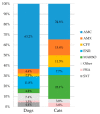Prevalence and Antimicrobial Resistance of Bacterial Uropathogens Isolated from Dogs and Cats
- PMID: 36551391
- PMCID: PMC9774110
- DOI: 10.3390/antibiotics11121730
Prevalence and Antimicrobial Resistance of Bacterial Uropathogens Isolated from Dogs and Cats
Abstract
Bacterial urinary tract infection (UTI) is a common diagnosis in companion animal practice and is one of the leading reasons for antimicrobial prescriptions. We analysed 1862 samples from the urinary tract of dogs and cats, submitted to a veterinary microbiological diagnostic laboratory in 2019 and 2020 in Germany. Susceptibility of 962 uropathogenic isolates to 15 antimicrobials, suggested as first- and second-line treatment options for UTI, was determined according to CLSI recommendations. Bacterial growth of uropathogens was detected in 43.9% of dog and in 38.5% of cat samples. Escherichia (E.) coli was the most frequently isolated pathogen (48.4%), followed by Enterococcus spp. (11.9%) and coagulase-positive staphylococci (CoPS; 11.5%). Females were more likely to exhibit a positive microbiological culture. Regarding first-line antibiotics, 93.4% of the most commonly isolated uropathogenic species were susceptible to the first-line antibiotics amoxicillin/clavulanic acid (AMC) and 87.6% to trimethoprim-sulfamethoxazole (SXT), while 76.1% showed decreased susceptibility to ampicillin (AMP). Multidrug resistance (MDR) was detected in 11.9% of E. coli, 50.4% of enterococci, and 42.7% of CoPS; 90.6% of these isolates were susceptible to nitrofurantoin (NIT). Our data indicate that empiric treatment of UTI with AMC or SXT could be recommended and is preferable to treatment with AMX. NIT should be considered for the treatment of MDR uropathogens.
Keywords: E. coli; MDR; enterococci; guidelines; nitrofurantoin (NIT); prevalence; staphylococci; urinary tract infection.
Conflict of interest statement
The authors declare no conflict of interest. The funders had no role in the design of the study; in the collection, analyses, or interpretation of data; in the writing of the manuscript; or in the decision to publish the results.
Figures



Similar articles
-
Antimicrobial drug resistance profile of isolated bacteria in dogs and cats with urologic problems at Chiang Mai University Veterinary Teaching Hospital, Thailand (2012-2016).Zoonoses Public Health. 2021 Aug;68(5):452-463. doi: 10.1111/zph.12832. Epub 2021 Apr 12. Zoonoses Public Health. 2021. PMID: 33844465
-
Antimicrobial resistance in clinical Escherichia coli isolated from companion animals in Australia.Vet Microbiol. 2017 Nov;211:43-50. doi: 10.1016/j.vetmic.2017.09.014. Epub 2017 Sep 21. Vet Microbiol. 2017. PMID: 29102120
-
Antimicrobial susceptibility patterns of aerobic bacteria isolated from canine urinary samples in South East Queensland, 2013 to 2018.Aust Vet J. 2024 Jul;102(7):362-368. doi: 10.1111/avj.13333. Epub 2024 Apr 24. Aust Vet J. 2024. PMID: 38654674
-
Antibiotic Resistance Among Uropathogenic Escherichia coli.Pol J Microbiol. 2019 Dec;68(4):403-415. doi: 10.33073/pjm-2019-048. Epub 2019 Dec 5. Pol J Microbiol. 2019. PMID: 31880885 Free PMC article. Review.
-
Bacterial characteristics of importance for recurrent urinary tract infections caused by Escherichia coli.Dan Med Bull. 2011 Apr;58(4):B4187. Dan Med Bull. 2011. PMID: 21466767 Review.
Cited by
-
Does Nitrofurantoin Improve the Portfolio of Vets against Resistant Bacteria in Companion Animals?Antibiotics (Basel). 2023 May 15;12(5):911. doi: 10.3390/antibiotics12050911. Antibiotics (Basel). 2023. PMID: 37237814 Free PMC article. Review.
-
The effect of consumption of cranberry (Vaccinium macrocarpon) on Escherichia coli adherence to feline uroepithelial cells in a blind randomised cross-over trial in cats.J Vet Res. 2024 Oct 9;68(4):583-587. doi: 10.2478/jvetres-2024-0055. eCollection 2024 Dec. J Vet Res. 2024. PMID: 39776678 Free PMC article.
-
Investigation of Bacterial Species and Their Antimicrobial Drug Resistance Profile in Feline Urinary Tract Infection in Thailand.Animals (Basel). 2025 Jul 30;15(15):2235. doi: 10.3390/ani15152235. Animals (Basel). 2025. PMID: 40805025 Free PMC article.
-
Impact of Antimicrobial Resistance of Pseudomonas aeruginosa in Urine of Small Companion Animals in Global Context: Comprehensive Analysis.Vet Sci. 2025 Feb 11;12(2):157. doi: 10.3390/vetsci12020157. Vet Sci. 2025. PMID: 40005917 Free PMC article. Review.
-
Significance of scattered small echogenic foci floating in urinary bladder as ultrasonography finding in dogs.BMC Vet Res. 2024 Aug 8;20(1):354. doi: 10.1186/s12917-024-04008-9. BMC Vet Res. 2024. PMID: 39118117 Free PMC article.
References
-
- Ling G.V. Therapeutic strategies involving antimicrobial treatment of the canine urinary tract. J. Am. Vet. Med. Assoc. 1984;185:1162–1164. - PubMed
Grants and funding
LinkOut - more resources
Full Text Sources
Miscellaneous

